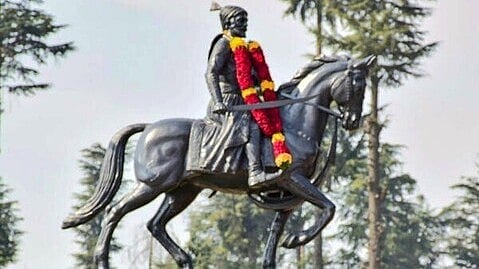
The statue of Chhatrapati Shivaji Maharaj.
Credit: PTI File Photo
Mumbai: Twelve forts associated with the life and times of legendary Maratha warrior Chhatrapati Shivaji Maharaj will figure in the list of UNESCO World Heritage Sites soon. The Centre and Maharashtra government are making concerted efforts in this regard.
India nominated “Maratha Military Landscapes of India” for recognition as UNESCO World Heritage List for the year 2024-25.
“Twelve forts associated with Chhatrapati Shivaji Maharaj will soon become World Heritage Sites,” Maharashtra Chief Minister Devendra Fadnavis said, coinciding with the birth anniversary of the iconic warrior-king.
Fadnavis, accompanied by Deputy Chief Ministers - Eknath Shinde and Ajit Pawar - visited the Shivneri Fort in Junnar in Pune district, the birthplace of Shivaji Maharaj.
The twelve parts of this nomination are Salher Fort, Shivneri Fort, Lohgad Fort, Khanderi Fort, Raigad Fort, Rajgad Fort, Pratapgad Fort, Suvarnadurg Fort, Panhala Fort, Vijaydurg Fort, Sindhudurg Fort in Maharashtra and Gingee Fort in Tamil Nadu.
Chhatrapati Shivaji Maharaj (19 February 1630 – 3 April 1680) was coronated in Raigad Fort on June 6, 1674 - and it is from here that he laid the foundation of ‘Hindavi-Swarajya’ of self-rule of the Hindu people.
As far as the nomination is concerned, the components, spread across diverse geographical and physiographic regions, showcase the strategic military powers of the Maratha rule.
The Maratha Military Landscapes of India, which were developed between the 17th and 19th centuries, represent an extraordinary fortification and military system envisioned by the Maratha rulers.
This extensive network of forts, varying in hierarchies, scales, and typological features, is a result of integrating the landscape, terrain, and physiographic characteristics distinctive to the Sahyadri mountain ranges, the Konkan Coast, Deccan Plateau, and the Western Ghats in the Indian Peninsula.
There are more than 390 forts in Maharashtra out of which only 12 forts are selected under the Maratha Military Landscapes of India, of these eight forts are protected by the Archaeological Survey of India.